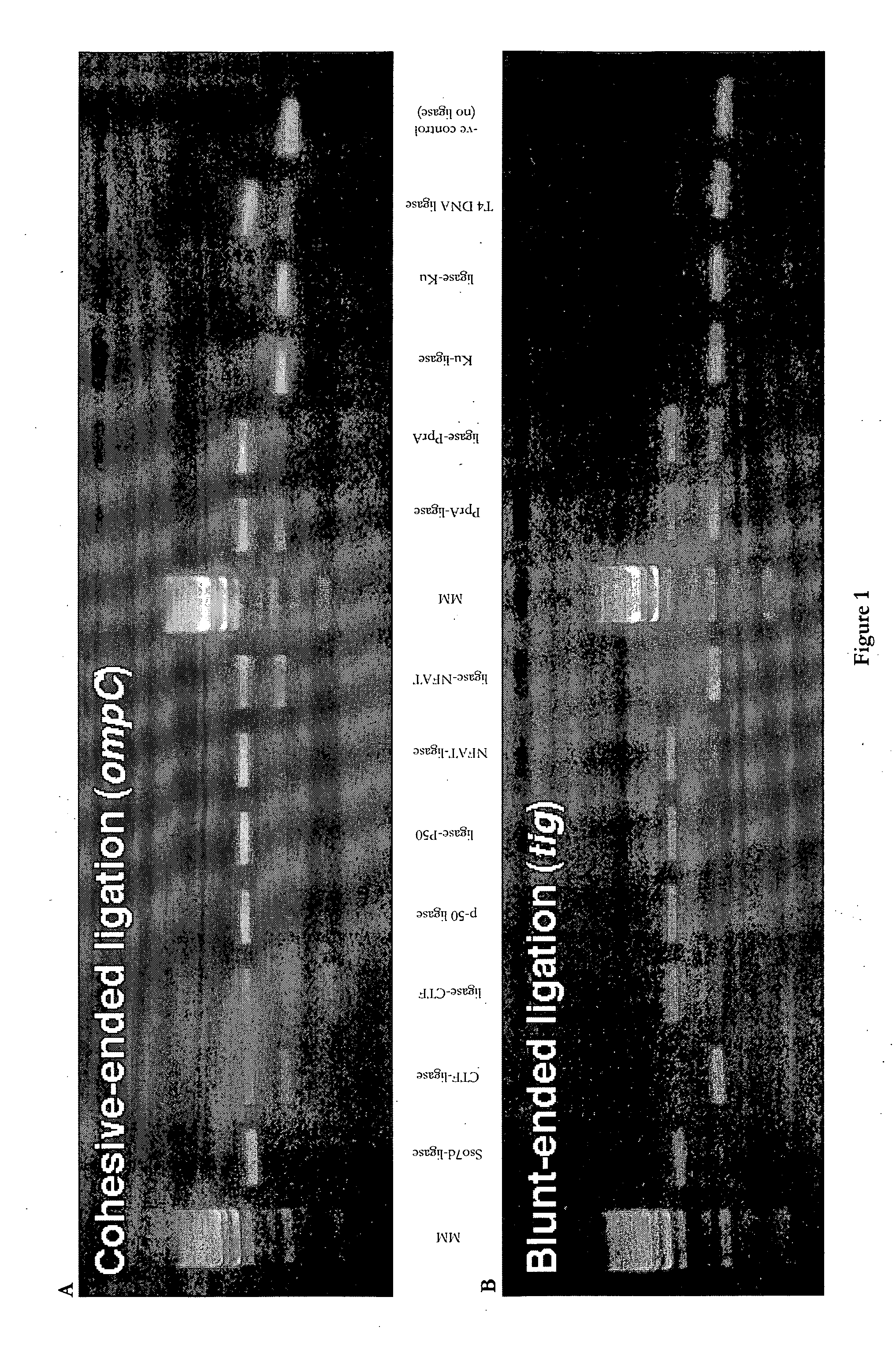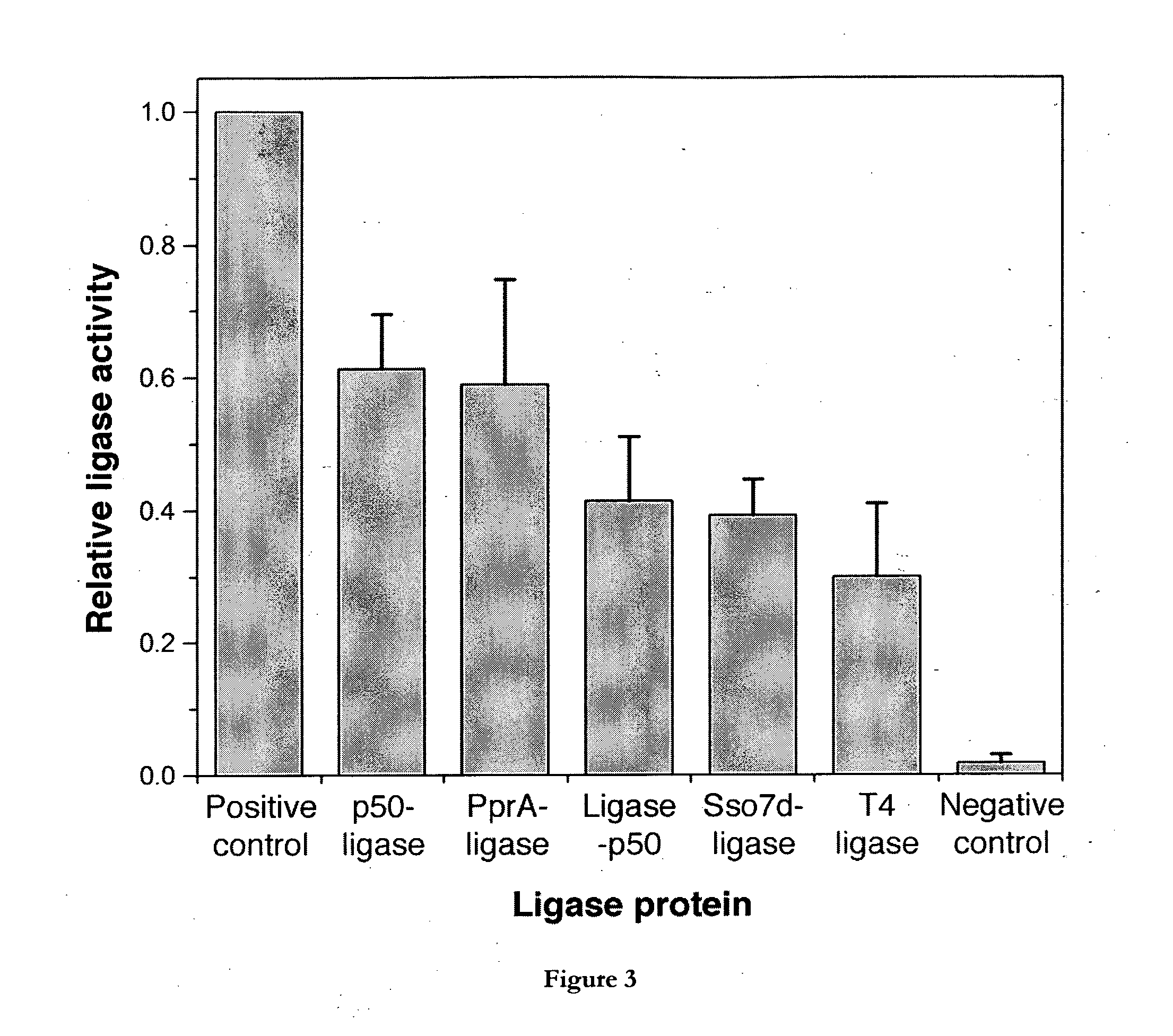Fusion polypeptides and uses thereof
a technology of fusion polypeptides and polypeptides, applied in the field of molecular biology, can solve the problems of little investigation into methods to modify the activity of ligases, and achieve the effects of improving stability, improving stability, and improving stability
- Summary
- Abstract
- Description
- Claims
- Application Information
AI Technical Summary
Benefits of technology
Problems solved by technology
Method used
Image
Examples
example 1
Construction of Plasmids and Production of Fusion Polypeptides
[0362]This example describes the construction of plasmids for the production in E. coli of fusion polypeptides comprising T4 DNA ligase (ligase) or E. coli ligase (LigA) fused to various DNA-binding polypeptides, as listed in Table 1 below. The orientation of the polypeptides comprising the ligase activity and the DNA-binding activity relative to one another is represented by the order in which the polypeptides are recited in the name of the fusion polypeptide—for example, p50-ligase refers to a fusion polypeptide comprising a p50 DNA-binding polypeptide fused to the N-terminus of a T4 DNA ligase polypeptide (optionally via a linking polypeptide), while ligase-p50 refers to a fusion polypeptide comprising a T4 DNA ligase polypeptide fused to the N-terminus of a p50 DNA-binding polypeptide (again, optionally via a linking polypeptide).
TABLE 1Ligase-DNA binding Fusion polypeptidesT4 DNA Ligase Fusion PolypeptidesDNA Ligase ...
example 2
Analysis of Ligation Activity of T4 DNA Ligase Fusion Proteins
Gel-Based Activity Assay
[0372]For cohesive-ended ligation, a 1,277 bp PCR product was generated by amplifying the plasmid pCA24N-ompC with the primers pCA24N.for (5′-GATAACAATTTCACACAGAATTCATTAAAGAG-3′, [SEQ ID No. 19]) and pCA24N.rev (5′-CCCATTAACATCACCATCTAATTCAAC-3′ [SEQ ID No. 20]). The PCR product was cleaved with the restriction enzyme SpeI, yielding two linear fragments of very similar size (638 bp and 639 bp). The two products of the cleavage reaction were co-purified and incubated in the presence or absence of various ligase proteins. 150 ng of substrate DNA was incubated with 20 pmol enzyme for 10 minutes at 16° C. The reaction was stopped by heating to 65° C. for a further 15 minutes. Ligase activities were determined by purifying the samples using Qiagen MinElute columns, and then running them on an agarose gel. Activity was measured as the appearance of the 1,277 bp ligated product, and the disappearance of t...
example 3
Analysis of Ligation Activity of E. coli LigA Fusion Proteins
Gel-Based Activity Assay
[0378]For cohesive-ended ligation, 170 ng of the SpeI-digested ompC substrate (as described in Example 2) was incubated with 20 pmol of each LigA enzyme for 17 hours at 16° C. The reactions were heat-killed (65° C., 15 min) and run on an agarose gel. In addition to the LigA-p50 and p50-LigA fusion polypeptides, native LigA ligase and three control samples were assayed.
[0379]Positive control—commercially available T4 DNA ligase (Fermentas)
[0380]Negative control—no ligase added
[0381]Commercial control—1 μL of E. coli LigA (New England Biolabs)
[0382]For blunt-ended ligation, 120 ng of the SfiI / SmaI-digested tig substrate (as described in Example 2) was incubated with 20 pmol of each enzyme for 17 hours at 16° C. The reactions were heat-killed (65° C., 15 min), and run on an agarose gel.
Results
[0383]Cohesive-ended and blunt-ended ligation activity of the LigA fusion proteins is shown in FIGS. 2a and 2b,...
PUM
| Property | Measurement | Unit |
|---|---|---|
| Composition | aaaaa | aaaaa |
Abstract
Description
Claims
Application Information
 Login to View More
Login to View More - R&D
- Intellectual Property
- Life Sciences
- Materials
- Tech Scout
- Unparalleled Data Quality
- Higher Quality Content
- 60% Fewer Hallucinations
Browse by: Latest US Patents, China's latest patents, Technical Efficacy Thesaurus, Application Domain, Technology Topic, Popular Technical Reports.
© 2025 PatSnap. All rights reserved.Legal|Privacy policy|Modern Slavery Act Transparency Statement|Sitemap|About US| Contact US: help@patsnap.com



